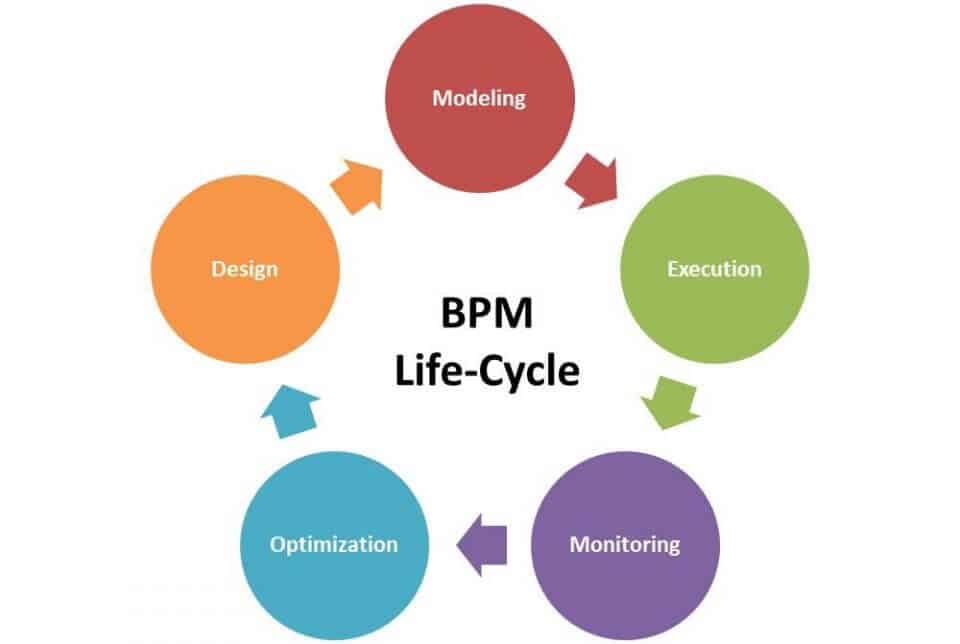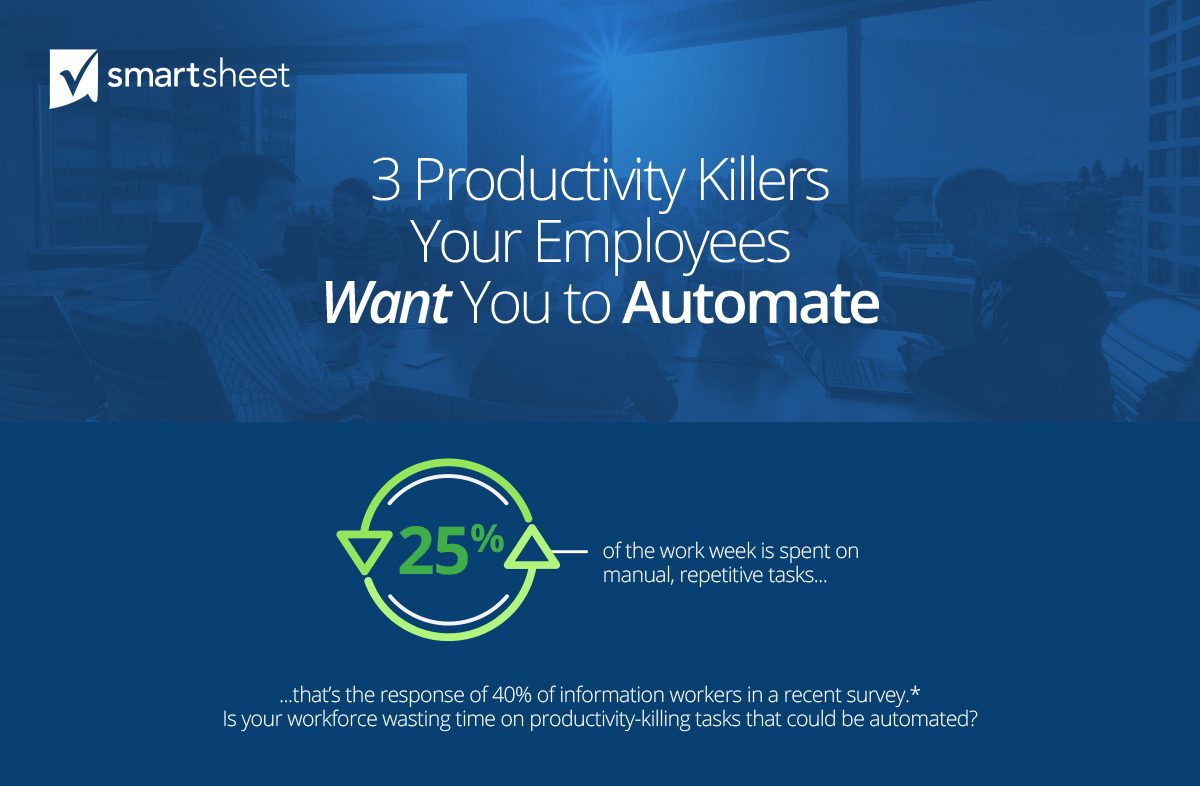What Is Business Processes Automation?
Business process automation (BPA) is a strategy wherein businesses use technology to organize their personnel and systems through workflows. Processes are the sets of activities that move your business toward a goal. Forrester predicts that automation can cut operating costs up to 90 percent with BPA.
BPA goes beyond traditional data management and records to advanced software systems and programs that integrate all your applications. Automation can permit your company to maintain control over various issues, such as customer relationships, analytics, planning, sales, standardization, and development. Automation can target not only complicated information technology tasks, such as managing your system users and troubleshooting network issues, but also programs like email marketing services.
BPA supports your knowledge workers and helps minimize operational costs, freeing up personnel to perform higher-level tasks. Clients are happier because you can assist them immediately and cut down on human error. In organizations where relationships are king, BPA can significantly enhance human interaction and decision-making, as well as create real-time transparency.
Three main tenets comprise BPA:
- It allows companies to orchestrate, integrate, and automatically execute.
- It centralizes your processes for the greatest amount of transparency, as it keeps the computing architecture intact. It coalesces the business functions that should logically be more integrated and spreads them out across the company.
- It addresses your human-centric tasks and minimizes the need for personal interaction.
There are four types of automation, progressing in complexity:
- Basic Automation: Basic automation centers are the simple jobs in your organization, giving a centralized place to store all related information. For example, using a centralized messaging tool for a topic or group allows transparency in communication, instead of hiding information in various email accounts.
- Process Automation: This documents and manages your business processes for task consistency and transparency. It is more powerful than basic automation and can be controlled by dedicated software and apps.
- Integration Automation: More complex than process automation, integration automation enables machines to observe the way that humans perform tasks and repeat those actions. Humans must define the rules, however. For example, you could integrate your BPM software and customer support software. This could give you results from a customer support checklist processed for each customer complaint and assign personnel when needed.
- Artificial Intelligence (AI) Automation: Adding AI to integration software enables decision-making where your technological support is humanlike. The system would make decisions on what to do with the data, based on what it has learned and constantly analyzed. For example, in manufacturing, AI automation can significantly reduce supply chain forecasting errors.
BPA is sometimes referred to as information technology process automation (ITPA). Implementing BPA can be a major event; because many business IT environments are virtual or cloud-based, their complexity can be challenging. Furthermore, in business process management (BPM), the automation element can take a backseat to defining the processes themselves. BPA concentrates on first automating the processes, then analyzing and optimizing them. BPA practitioners know that business needs change rapidly and there’s often no time for substantial business process modeling and mapping projects prior to software selection.
BPA is often confused with other terms such as industrial automation, robotic process automation, smart factories, infrastructure management, and enterprise risk management. Industrial automation (IA) uses control systems such as computers to automatically run industrial processes. Primarily found in manufacturing, it replaces the human element and improves the production rate through consistently managed processes. Whereas BPA automates processes and workflows, IA strictly automates the physical human labor in processes and workflows.
Robotic process automation (RPA) is an emerging field that specifically automates artificial intelligence, machine learning, and robotics. Although the technology is getting savvier, RPA mimics high-volume, repeatable human tasks, leaving more abstract duties such as relationship building to the humans. RPA complements BPA, after it streamlines your processes.
Smart factories are production environments that continuously improve and self-optimize. The “smart” label applies not only to goods production, but also planning, logistics, and product development. Communication technology connects the production process, with integration possible across the entire supply chain.
Enterprise risk management (ERM) is another related term. In ERM, the organization plans for all the potential risks of regular business activities and accidents, including financial, operational, and strategic scenarios. In this context, you would plan for the risks of automating your business processes.
Both are similar to infrastructure management (IM), the larger discipline that encompasses BPA and IA. IM handles all operation pieces, such as all policies, procedures, processes, data, people, and customers.
The Elements of Business Process Automation
Most BPA efforts involve three elements:
- Business rules and logic
- Structured data
- Unstructured data
Business rules and logic include the stipulations, reasons, data, and documents that support your business parameters. Some of this logic may be fully automated, while other portions may need to be reviewed by someone involved in the process.
Structured data is the information in your enterprise applications that you reference when making process updates. This data is highly organized and easily detectable by search engine algorithms, as it appears in fixed fields within your records or files. Machines can generate structured data (such as manufacturing sensors that produce the temperature of rotation count), and so can humans (such as those filling out the age, gender, or ZIP code fields of a form).
While unstructured data is more subjective and usually quite text heavy, it is extremely important, as most information used to make business decisions is unstructured. This data can come from many sources (for example, social media) and is difficult to put into a structured format of columns and rows for easy extraction and analysis. BPA platforms aim to seamlessly integrate these three elements.
The BPA software systems that you can find to support your automation may differ by whether they can address AI and advanced analytics. BPA can address these aspects of process design:
- The ability to assess process workflows and redesign
- Help in determining what automation elements are needed and how they fit into the larger business scenario
- The ability to deploy accelerated proofs of concept using specified solutions
- Integration of AI
The Evolution of Business Process Automation
Manufacturing automation began in 1913 with Henry Ford and the production of his signature Model T cars. With the first moving assembly line for the mass production of an entire automobile, Ford revolutionized the production process and the automotive industry. With this radical change, assembly lines enabled each worker to refine their individual skill set, which delivered huge cost savings for every completed product.
As technology rose in the 1970s and 1980s, businesses started to use computers for rudimentary automation. Dull, repetitive tasks and processes shifted to machines, and humans gained the opportunity for more creative and high-level jobs.
Today, BPA is a normal part of the toolkit for process excellence and continuous improvement, with components like systems integration, enterprise resource planning (ERP) systems, and workflow tools. With the Internet of Things (IoT) connecting objects to the digital world, BPA enables the transfer of data over a network without any human interaction. Advances in mobile technology have enabled a remote workforce, which can dramatically decrease company expenses.
What Is Robotic Process Automation?
Robotic process automation (RPA) is about more than automating your processes. RPA uses algorithms, artificial intelligence (AI), machine learning, and bots to perform higher-level functions. A type of BPA, RPA has evolved from the combination of AI, screen scraping, and workflow automation. Where BPA aims to automate processes to work in concert with people, RPA attempts to replace the people in the processes and replicate human behavior with technology. RPA uses software robots (bots) or AI and machine learning (ML) capabilities.
Unlike BPA, RPA can adapt to changing circumstances. Scenarios for RPA can be as simple as sending an email response or as complex as using bots in an ERP system as automation. Companies that use RPA include Walmart, Deutsche Bank, AT&T, Vanguard, Ernst & Young, Walgreens, Anthem, and American Express Global Business Travel.
Like BPA, RPA can reduce human error and the cost of employing a large staff. Bots do not require custom software, and they are fairly low cost and simple to integrate. According to McKinsey & Company, the return on investment for RPA varies between 30-200 percent in the first year, mainly in labor savings. One company in banking was able to add 85 bots with the capacity of 200 staff members, cutting its recruiting cost by 30 percent.
RPA alone covers mostly low-value tasks, but when combined with ML and AI, it can automate higher cognitive tasks. This includes work that requires perception and judgment, sometimes intelligently automating 15-20 steps of a process. Gartner says that by 2020 the RPA market will top $1 billion, going from use in less than 10 percent of businesses to about 40 percent, and reducing the human need in service-share centers by 65 percent.
Experts say that businesses should use RPA in alignment with their enterprise goals, placing it in their workforce strategically, and not because it is the latest development. Remember: Poor design that does not incorporate change management will wreak chaos.
As you learn about RPA functionality and suitability, build an automation roadmap in concert with your progress. Also, put together a broader enterprise plan, highlighting where automation could help. Make sure that your business leaders understand the limitations and capabilities of RPA as you ask them to review their departments. This helps them set and manage their expectations. In particular, review organizational areas with suboptimal performance to determine where RPA may be suitable. You should consider RPA opportunities in your overall development lifecycle.
To effectively manage RPA, companies should involve IT early and often, designating an IT RPA expert who can help you manage the volume of data you decide to collect. You should also have an RPA project manager who provides structure to the implementation. In businesses with compliance requirements, controlling the project rollout will maintain good governance. Other experts suggest building an RPA center of excellence that gives your personnel the resources they need when they have questions and issues for a more manageable impact on your employees.
Workflows, Workflow Automation Software, and Business Process Automation
Business processes are the series of activities that companies put in place to create a product or to benefit another internal workflow. Business processes can cut across various departments and often impact customer satisfaction. Workflows are visual diagrams that help automate these processes by increasing ease of use, speed of production, and consistency.
A wide selection of workflow automation software can help you get started. Most of this software helps you build your workflow diagrams with inputs, outputs, and rules for how the system behaves. It then acts as your management system and allows you to tweak and reorganize your workflows over time. However, some workflow software acts as a link between disparate software applications. This type of software uses open application program interfaces (APIs) to integrate the most popular software systems and create workflows from different programs.
For more information on workflows, see this article. When choosing workflow management software, see these expert tips.
Where Should Business Process Automation Live?
Experts often debate whether BPA should live in line-of-business (LOB) or enterprise-level software. Business process management software (BPMS) suites are comprehensive, enterprise-level application infrastructures that act as platforms to create, manage, and optimize your business processes. They focus on managing multiple workflows within an organizational structure. Moreover, they work within the confines of industry standardization and can be coupled with methodologies such as Six Sigma, Lean, and the Theory of Constraints.
BPMS may seem the same as BPA, but it is not. BPA can be a part of a BPMS, but BPMS is mainly concerned with managing processes. Some BPMS suites automate processes, but no BPA software manages processes. In other words, all BPA can be a form of BPMS, but not all BPMS includes BPA.
Experts say that BPM has five to six stages: planning and strategic alignment, process analysis, process design, process implementation, process monitoring, and process refinement, although the planning and strategic alignment stage is under debate. Regardless, all experts agree that the last step should include continuous improvement activities, making the overall process a cycle that never really ends.
Credited to: Mariska Netjes, Halo A. Reijers, Wil M.P. van der Aalst.
For more information on BPM and BPMS, see this article.
Line-of-business software is a set of critical computer applications for running a department. LOB targets one business need or customer issue and is usually developed in-house to meet specific targets. At the same time, enterprise software is a collection of customizable programs for a whole organization, requiring specific business and computing knowledge for implementation. It is meant to serve the entire organization — not just one area or division — with a specific business logic.
Reasons to Automate Your Business Processes
Every day, your employees schedule appointments, request approvals, revise documents and workflows, route information, and look for status updates. In many businesses, people still perform these actions manually. This can be a struggle when you have to scroll through multiple email revisions, replies, and forwards to find the current version of a document. It can also be a challenge when you miss an email that gives you an approval before everything’s ready.
When someone asks you for an update, can you be sure that your reporting is correct? What happens if the sales team changes the prices and doesn’t update the document you’re quoting from? These inefficiencies can cost your company money. They also decrease your company’s accountability, not to mention wreak havoc on company compliance and customer satisfaction.
Automating these processes can help reduce stress. Self-automating activities eradicate worries about missed emails or someone taking a sick day. According to a 2017 Forrester report, companies that master automation will take over their industries. Businesses typically automate their processes to:
- Streamline communication
- Enforce accountability
- Minimize costs
- Reduce paperwork
- Decrease defects and manual errors
- Keep a tab on business processes
- Establish a clear approval hierarchy
- Improve workflows
- Decrease the time it takes to perform repetitive tasks
- Maintain a consistent process speed
- Ease and speed up auditing and analysis
- Create more flexibility, so it’s easier to make changes
- Foster a happier and more stable workforce
- Satisfy customers and, thus, increase your business’s competitiveness
- Reduce human errors and variance
- Produce faster responses to mission-critical system problems
- Allow more efficient allocation of resources
- Maintain a consistent work standard
- Give customers a flexible platform
- Offer a digital labor model
Top Processes You Should Automate
In addition to the reasons listed above, there are a few processes your employees wish you would automate. Check out our latest infographic showing the top three productivity killers that you should automate.
What Business Processes Should You Automate?
McKinsey & Company estimates that about half of all business processes — including yours — can be automated. Automation could save your business a lot of money, but you may be wondering what processes to start with and what is even possible. First and foremost, review the strategic and operating drivers for improvement. Then look for the processes. Rote and repetitive tasks are one obvious place to start.
Other processes that can be automated include:
- Sensor-based tracking and alerts
- Employee self-service portals
- Risky manual tasks
- Back office processes
- Research
- Management of documents
- Moving documents between programs or folders
- Copying and pasting data between programs or software
- Adding events to calendars
- Customer or lead follow-up
- Collecting or sending documents for signing
- Invoicing
- Customer feedback collection and processing
- Identifying image content
- Customer complaints
- Some decision making (defined)
Who Automates Their Business Processes?
Each industry has different business process automation needs, but BPA can improve every industry. Examples of industries that can benefit from BPA include sales, fire and security, higher education, K-12 education, digital education, state and local government, federal government, justice systems, contract management, case management, cement and building materials companies, and any corporate-level company.
With the objective of automating as many manual processes as possible, businesses are turning to the principles of BPA to foster improvement. Here are some examples of how different industries can benefit from BPA:
- Healthcare (including sectors like hospitals, biotech, pharma, medical devices, and laboratories) has concerns around quality and risk management. This industry looks for support for good practices (GxP) in connection with record management, electronic signatures, and project management.
- Banking needs center on loan processing, automating credit and money transfers, integrating with other automated bank system ABS and card systems, and managing budgets, along with front- and back-office systems development.
- Telecommunications looks to BPA to automate its office systems, customer service, billing systems, databases, document and workflow management systems, and technical support.
- Trading and manufacturing require BPA to automate manufacturing processes, CRM, ESB, and ERP systems, warehouse and procurement activities, and document-flow management.
These days, all industries can benefit from managing their social media, especially firms that need specified branding and an active public presence in the marketplace. Other industries look to BPA to automate and manage projects and portfolios, knowledge assets, workflows, cases, and data flows.
How to Get Started on a Business Process Automation Project
Where do you begin with a BPA project? How do you identify which processes should be automated at the beginning? Companies should select the processes by first looking at their strategic needs. In this way, companies should ask themselves what will make them more competitive in the marketplace. For instance, you may be concerned with getting goods to market quicker (or first) or decreasing the price of your products by improving your margins.
Next, companies should pinpoint processes that are operationally greedy. These are the processes that take up extensive time or resources and are often rife with human error.
Each organization will vary in the order of automation, based on their strategic and operational needs. Look for the following process types to determine where to begin:
- Simple and repetitive
- Technology back office
- Research
- Document management
- Finance management
- Decision-based, but able to be addressed by a machine (matrix-answered)
- Manual tasks that could cause human injury
- Purchasing
- Order management
- Sales and marketing
- Tracking and alerts (by sensor)
- Rote human resources
- Manufacturing
- Legal
- Financial
- Administrative
- Human resources
- Business development
The Four Phases of Business Process Automation
Project managers could divide BPA into four main phases. You can drill down into more granular steps, depending on the specifics of your organization and whether you bring in external consulting for your BPA project.
The four phases of BPA:
- Analysis: In this phase, you review your organization’s infrastructure. Assess its requirements and objectives before performing a full review of the current systems, data needs, and business processes. Then select a technology solution based on its architectural design and its fit with the business. At this stage, external consultants who are experts in the technology are helpful.
- Implementation: During this phase, set up and customize the technology. If necessary, extend the current IT systems with specialized plugins and add-ons. At this time, documentation is critical, and you should record each and every functionality. You should also implement administrator and select end-user training, followed by end-to-end and user-acceptance testing to determine feasibility before the next phase.
- Integration: At this phase, perform API integration. This enables the new programs to access and communicate with other existing programs. You should also perform data integration during this step, combining data from disparate sources. Lastly, implement the enterprise service bus (ESB) in a service-oriented architecture (SOA). An ESB allows communication between software applications.
- Maintenance and Support: This last phase seeks out bottlenecks and flaws in your processes so that they can be corrected. You should continuously update your system versions, with consistent migration to new platforms as they are available. The whole organization should also be able to take advantage of technical support.
How Can You Improve Your Business Through Process Automation?
When it comes to business process automation efforts, our experts from around the web give several recommendations for how to get started. Some say that the projects are only successful if you initially approach them from the position of the desired outcome. Others recommend automating first, then figuring out the processes. Some claim that a full map and model of your processes are required prior to any automation. Experts also extol the virtue of having your business leaders on board, even as part of the team. Finally, they emphasize that you should improve all your processes (not just the automated ones) to maximize usefulness. In other words, garbage in, garbage out.
Sourced from around the web, here are other tips for BPA projects:
- Figure out the source of your workflow problems
- Understand what compliance your company requires
- Document everything, even how you document
- Define your goals: specific, measurable, attainable, relevant, timely (SMART)
- Look for a contractor with solid enterprise content management (ECM) experience
- Present a convincing business case for the automation to your leaders
- Build your team’s confidence by finding the quick wins
- Implement one complete BPA event at a time
- Link current software to create custom integrations
- Use a BPM system after you map your end-to-end process workflows
- Integrate your BPM system to your other programs, services, and platforms
- Consider AI automation as a layer between your data source and your databases
An example of a good use of BPA is in customer success activities. Automation ensures that your team members can spend their time on the high-touch work needed to retain your customers (such as onboarding) instead of data entry. Data entry is rife for errors and mishaps, and it relies on the team to communicate the customer information to each other.
By automating the onboarding process, you can convert sales leads into corporate clients and update the lead status in the customer relationship management (CRM) program. This could trigger the client onboarding checklist in the software, with new client information automatically loaded into the new checklist. Your company could automatically send onboarding materials to the client via email and notify a team member on what they need to do for the new client with instructions from the checklist. The new process is more efficient and communicates without error to the team member.
Another example is automation in human resources (HR). You can automate the recruitment and employee onboarding processes. In many companies, job descriptions and applications are not stored in a central location, while the screening and interviewing process is based on your current employees’ accountability, meaning that the process may be inconsistent and could open up your business to possible hiring bias. Onboarding can also vary among employees.
Using automation, your team member would select the department and the position they are hiring and download the automated checklist. This checklist would update to reflect the necessary tasks to recruit and onboard this type of employee. Each interviewee gets a fresh checklist, and all the interview and hiring information is automatically stored in a central location. Once the choice is made, the hiring process pushes the information to the onboarding process.
A final example of automation is for customer support. SiriusDecisions reports that about 64 percent of a salesperson’s time goes to administrative tasks instead of selling, and 73 percent of customer support professionals say that the most challenging part of their job is managing time and workload. Automation can minimize the burnout for these professionals by enabling them to concentrate on the higher-level functions that touch your customers.
Normally, customers reach out to your company with an issue. They must explain the issue to every person they encounter, and the response time can vary widely. It is difficult to track where the problems initiate and whether the patterns could be systemic. Your customers’ ability to find a solutions usually depends on the knowledge of the team member they reach.
Automation can standardize your company response to customer issues. Once the customer contacts your company with an issue, a process immediately kicks off and prioritizes the support request based on defined criteria, such as the customer value and the nature of the problem. The software assigns support personnel and categorizes the type of issue. Between the predefined criteria and assigning the employee, the system escalates the problem. Along the way, the app notifies the customer of each step, assuring them that the issue is being handled.
When Not to Automate Your Business Processes
Regardless of the good intent and benefits of automation, there will be cases where automation is not appropriate, and the human touch and analysis are needed. For example, customers appreciate being able to automatically book a hotel or travel accommodations without waiting to speak to agents. It becomes irritating, however, when calling travel companies and figuring out what option on the phone tree will take them where they need. Further, it can be infuriating when a call is dropped or hung up, especially if they are having problems on the trip.
When decisions are high-level, total automation may not be suitable. When environmental cues are needed to make the decisions — such as on automatic vehicles — accidents can happen. Some companies that have brought to market voice and visual-based automation have discovered that the physical world may be too difficult yet for the response needed. This could be a matter of time and constant testing, but humans may still need to make these types of environmental-response decisions.
You should be aware that certain types of automation will eliminate jobs. Forrester Research estimates that 7 percent of jobs (about 230 million) globally will be eliminated because of AI.
Additionally, many RPA implementations fail because they are not well thought through or executed in concert with the company’s strategic direction. Further, soundly implementing bots is critical, and changes during the process, even those required by compliance needs, can throw them off. They do not always have the necessary flexibility configured when platforms change. This has caused some companies to either refuse to install bots or to put their installation on hold, according to a McKinsey & Company report. A Deloitte UK study indicated that only 3 percent of progressive leaders have been able to reach an RPA scale of 50 or more bots.
When done well, RPA can be a huge cost savings to a company. But even when you automate X percentage of tasks, it may not mean you get that same X percentage in cost reduction.
What Experts Have to Say About the Current and Future State of Business Process Automation
Coming from vastly different businesses, our experts offer a wide range of opinions about the current and future state of BPA. Some seem concerned about the disruptive technology that BPA may bring (regarding robotics and artificial intelligence), while some are pleased that it helps improve their business.
She continues:
- Strip the process — i.e., remove unnecessary or redundant steps. Start back with the bare bones.
- Simplify the process. Look for ways to merge steps, minimize steps, or optimize the overall process.
- Standardize the process. Make the process repeatable (and hopefully autonomous), and document the best practices.
- Sustain the process. Keep going and improving, because there is no such thing as a perfect process!
Roberts notes, “Streamlining processes is my expertise, so I have a lot of experience here. Here's one high-level example: I worked on a technical risk management process that involved process streamlining and troubleshooting. Process upsets were two to three times more than plan. Staff satisfaction was poor. Annual business targets weren't met. After automating and streamlining that process, the process upsets were reduced to within 10 percent of plan. Staff satisfaction increased 20 percent. The business started meeting targets and saved over $3 million from efficiency gains. Talk about some serious results from automating!
“As for the future of business process automation, I see businesses tending more toward computer-based automation to eliminate human action as much as possible. Human intervention will be needed only for complex troubleshooting, higher-level analysis, oversight, and strategic thinking.”
“I use Zapier to automate my outreach and collect user stories to feature in blog posts. After compiling a list of users to reach out to in a Google Sheet, I set up an automation between my Google Sheets and my Gmail. Then, every time I update a row in my Google Sheet, the system sends a personalized email to the user using a template I created. The email has a link to a Typeform survey with a couple of questions. After users submit the survey, their answers are automatically routed back to the Google Sheet. With this automation, I can spend more time crafting a piece of content and less time manually compiling the information I collect.”
“The best way to optimize marketing automation is to connect it with a customer relationship management (CRM) platform. If your business brings in revenue by combining marketing and sales campaigns, then your system should be integrated. Connecting your marketing automation platform with your CRM will help marketers on your team connect crucial campaign strategies with the financial outcomes. This will provide your salespeople with better visibility into prospecting and leads. It also allows your marketing team to hand leads over to sales without manually exporting anything.”
“I’ve worked with many clients to improve their business process efficiency. The main way I achieve efficiency is through the integration of financial and operational applications. There are many ways to use cloud applications to get rid of redundancies, reduce data lag/availability, and — by eradicating human intervention — improve accuracy in the collection of data. You will often observe that a human entering or moving data through a process is susceptible to inaccuracies and the delays of office life. By automating these processes, you reduce or eliminate the inaccuracies and can significantly cut down on the time it takes to get actionable data.
“For example, one process automation involved a distribution company that sold primarily to big-box retailers. In its old state, the organization had no window into what customers were ordering until after the warehouse fulfilled it. In addition, they would get a report once a week, which required someone to manually manipulate the data and import the data into the accounting software.
“In the new state, every time a customer places an order, it is instantly created in the accounting software. It is then sent to the warehouse to be fulfilled. Once fulfilled, it is automatically converted to an invoice that can be sent out to the client. This gives the executive team real-time visibility into what has been ordered, what is unfulfilled, what has been shipped, and when the company has been paid. All of this data is available on any internet-connected device and requires zero human intervention. Needless to say, the executive team loves the new insights!
“I think we are going to see BPA take a different shape in the near future. We are going to see a more mainstream adoption of AI that will allow for deviation from a binary process. There are applications out there now that can handle a lot of these tasks. However, due to financial constraints, the adoption at smaller companies is extremely difficult. As the technology becomes more developed and the cost comes down, artificial intelligence will be far more mainstream.”
“We help our customers address the technology issue. Once they have their automation processes identified, we let them implement those processes on top of the cloud systems they use. For example, automating marketing across email, social, and mobile channels to engage prospective customers, automating the sales process on top of the customer’s CRM, implementing collaboration software, and using documents to shorten the sales cycle and convert more prospects. From a technology perspective, there are a lot of BPA enablers: AI, bots, and automation/integration tools (like ours). There was a lot of buzz around the same in 2016. This will make it increasingly simple to achieve BPA once the people and process parts are taken care of.”
“So I ask myself the question: What happens in a consumer-based society when the consumers are progressively displaced from the job market by AI-driven technology? And the corollary: Who is working on that end of the equation as fast as the evolution of the displacement? In other words, Where are new jobs being created at a rate that even remotely approaches the losses? What we are seeing now is that lower-paying, part-time gig economy, and service-industry jobs are replacing careers.
“Unfortunately, nobody, at least as far as I can see, is addressing this fact. Fewer and fewer people are required to provide goods and services for many. Extend this trend out a decade, two decades. See what you come up with!”
“We have introduced the Plustek eScan stand-alone scanning kiosk to several companies where people need to quickly convert paper documents into digital ones. This scanner allows them to log in and send the information to preset locations at the touch of a button. This not only saves a ton of time, but also provides the ultimate secure solution because the user cannot send the files to another location, either intentionally or by accident.
“Many companies are also using zonal OCR and barcode scanning to automate document filing. Zonal OCR lets the user set a predefined area from which information is automatically captured, indexed, and added to a specific database. Many companies employ Zonal OCR on their purchase orders so that scanning the document will transfer the invoice number and shipping and billing information directly to a database. Adding barcode recognition to a document automates the filing process by telling the computer where and how to file a document and its content. These capabilities help these large, established companies compete today.”
“As a solution, we automated this outreach through our RepuGen software, getting customer feedback and turning the positive comments into reviews. The second way I automated to improve my business was when I created an online portal for my online transcription services company, GMR Transcription. This online portal eliminated the manual process of receiving and uploading audio files, and instead made it possible for the clients to do it themselves.”
“With the use of automation tools like CRM software, it is easier to quickly resolve customer complaints. Automation helps you deliver excellent products and services with robotlike efficiency: quick order fulfillment, faster service delivery, and seamless logistics. As a digital marketing agency, we always use SEO software, such as Screaming Frog or Xenu, for BPA. This helps to reduce our effort and increase our on-page optimization. Most companies spend a significant amount of time, effort, and money training new employees on their way of doing things.
“In the future, BPA will allow organizations to define their own processes and process flow. It will endow employees with the ability to have a single sign-on to a complete solution, providing the unprecedented access that people want. Adopting business process automation will remove the guesswork of delegation and responsibility almost completely in that everyone’s direct responsibilities will be clearly defined and integrated within the platform.”
Learn How to Automate Your Business Processes
When discussing BPA, all experts agree that, time and finances permitting, you need to get back into the classroom. Luckily, numerous software platforms can support your BPA efforts. However, some platforms are far less user-friendly than others and require instruction to learn enough for a BPA project. One of those platforms is SharePoint.
SharePoint is a cloud-based Microsoft product that can be used for BPA and for document storage and collaboration. Training for SharePoint goes from the basics (for users who will stick to low-level functionality) to the advanced superuser and even administrator designation (for professionals who want to act as their company’s point of contact for their internal or external SharePoint site). Programming courses in SharePoint are also available for professionals who need to code new applications.
The BPA-related SharePoint courses cost about $2,000, and some come with a certificate verifying completion. These courses teach you to work with a SharePoint site and to manage documents and workflow processes. Instructors offer these courses online, as well as in group, in-person settings. Courses typically include topics such as:
- Working with sites
- SharePoint lists to manage BPA
- SharePoint libraries
- Content types
- Enterprise content management
- Infopath form services
- Alternatives to SharePoint forms
- Uses of SharePoint Designer
- BPA using workflow
- Creating custom workflows
- Advanced workflow topics
- Customizing for BPA
Opinions vary on the efficacy of SharePoint for BPA. If SharePoint is a historical program for a company, it may be a no-brainer to continue and expand its use. However, many experts claim that SharePoint does not have the real-time collaboration capacity that is necessary for BPA. For more information on SharePoint for document management, see this article. To learn about alternatives to the platform, read these tips.
The Different Programming Languages of Business Process Automation
Developers have used a programming language to develop every business process automation tool. However, they often develop unique, customized automation tools based on an organization’s needs. It is critical to have someone with knowledge of the language specific to an organization’s BPA tool, especially for large organizations. To determine which language is the best to learn, experts recommend looking at the programs already in use at your company, the current team’s knowledge, the framework of the project with respect to what has already been developed, and what kind of support is available in that language. Common automation languages include Java (Java SE, Java EE, Java ME, and Java FX platforms), C# (.Net platform), PHP, Ruby, JavaScript, BPM, and ESB (IBM BPM, Pega PRPC, and Pega Mobile).
Build Powerful, Automated Business Processes and Workflows with Smartsheet
Empower your people to go above and beyond with a flexible platform designed to match the needs of your team — and adapt as those needs change.
The Smartsheet platform makes it easy to plan, capture, manage, and report on work from anywhere, helping your team be more effective and get more done. Report on key metrics and get real-time visibility into work as it happens with roll-up reports, dashboards, and automated workflows built to keep your team connected and informed.
When teams have clarity into the work getting done, there’s no telling how much more they can accomplish in the same amount of time. Try Smartsheet for free, today.













